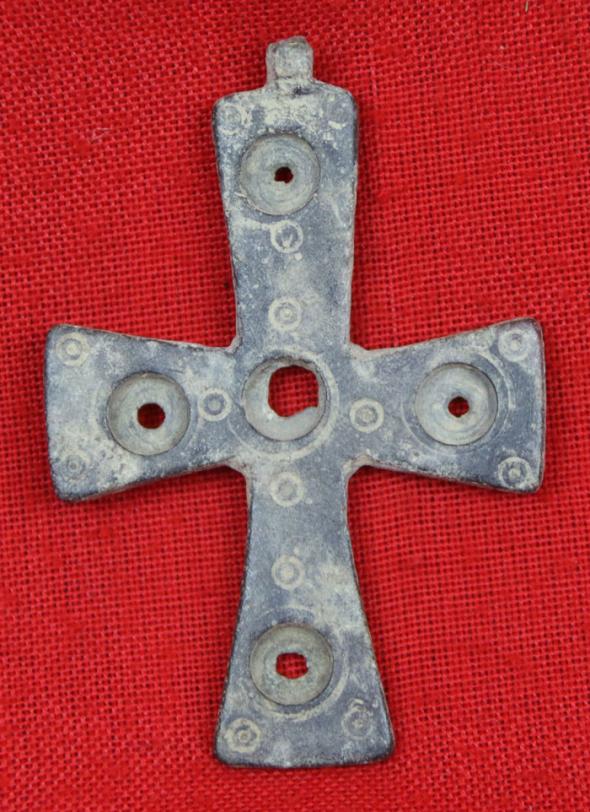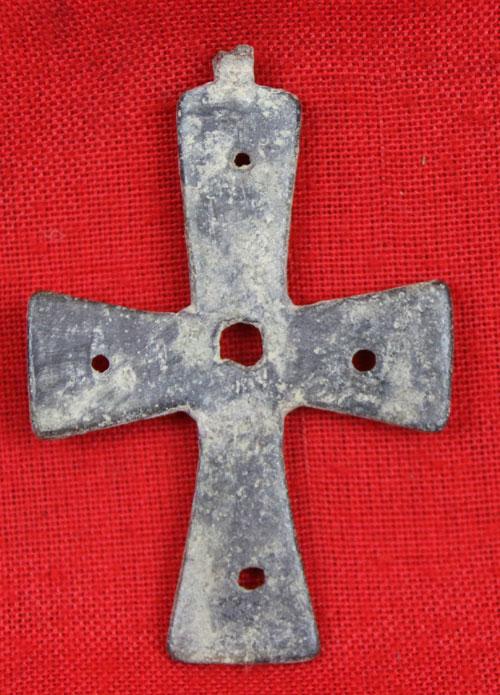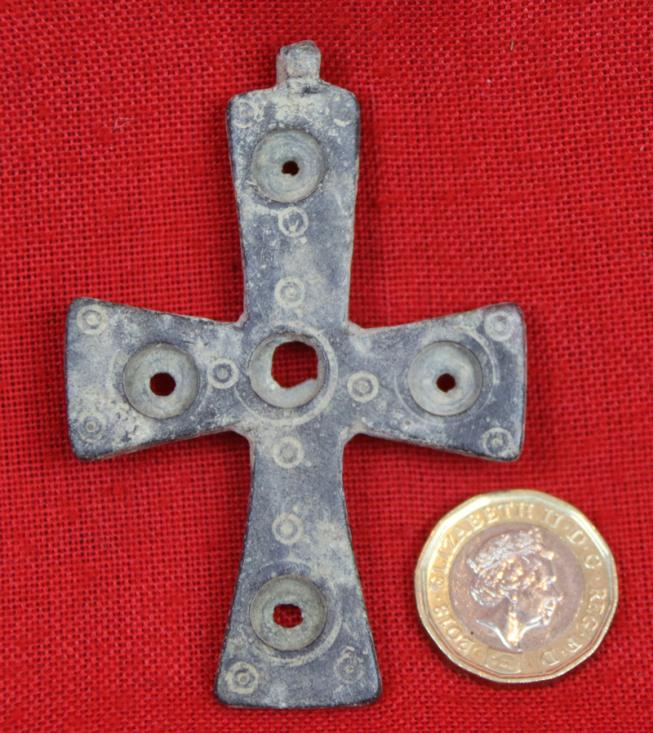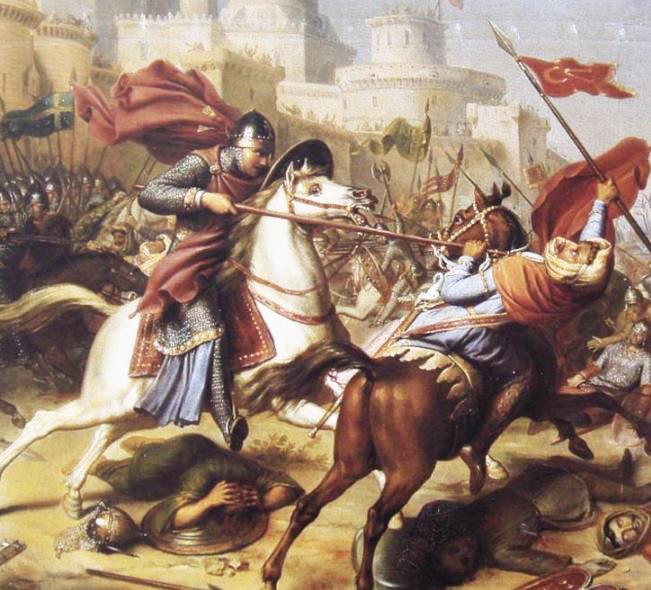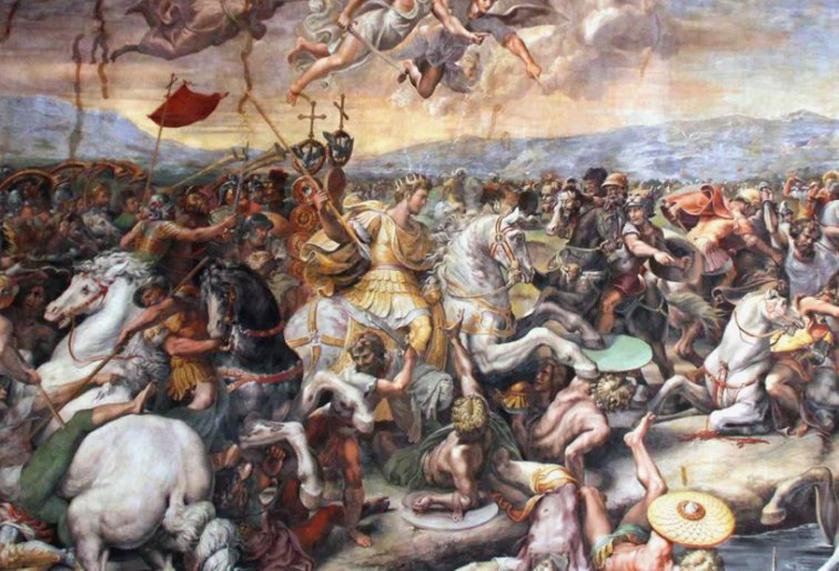A Fabulous, Most Rare & Exceptionally Large, Imperial Roman Byzantine Empire, Original, Incised & Pierced Pectoral Stigmata Cross 4th to 10th Century AD from Jerusalem. Used from the Time of Emperor Constantine to the Earliest Crusades.
In superb condition, it is exceptionally rare due to its large size, extraordinary large {yet wearable} size with beautiful patination, almost 3" long. The stigmata cross represents the five wounds of Christ. The incisions could be set cabochon gemstones such as ancient garnets.
The form of earliest Christian Cross Crucifix worn around the neck over the Roman toga to clearly show one’s position as, say, a Christian noble or tribune of status in the Eastern Roman Empire of Emperor Constantine, and it may have been worn by subsequent generations as a symbol of continuity and stability and devotion of the new faith of the Empire. Later, in the evolution of Christianity in the East, acquired by or presented to a Crusader Knight and worn upon his tabard as a symbol of his devotion to liberating Jerusalem.
One of our clients bought a fabulous good sized Crusades period bronze cross from us recently, and had a jeweller make a wearable gold mount and hanging ring so it could be worn once more almost 1000 years since it was originally worn to the Holy Land. Another client acquired an encolpion cross and had a bespoke good sized frame made for its display, both looked absolutely stunning.
Just over 1700 years ago, it was written, a cross of light bearing the inscription “in hoc signo vinces” (in this sign you will conquer) miraculously appeared to Roman Emperor Constantine before the battle of Milvian Bridge. The Battle of the Milvian Bridge took place between the Roman Emperors Constantine I and Maxentius on 28 October 312. His victory over his brother-in-law and co- emperor Maxentius and subsequent conversion to Christianity had a profound impact on the course of Western civilization.
Byzantine is the term commonly used since the 19th century to refer to the Greek-speaking Roman Empire of the Middle Ages centred in the capital city of Constantinople. During much of its history, it was known to many of its Western contemporaries as the Empire of the Greeks, due to the dominance of the Greek language and culture. However, it is important to remember that the Byzantines referred to themselves as simply as the Roman Empire. As the Byzantine era is a period largely fabricated by historians, there is no clear consensus on exactly when the Byzantine age begins; although many consider the reign of Emperor Constantine the Great, who moved the imperial capital to the glorious city of Byzantium, renamed Constantinople and nicknamed the “New Rome,” to be the beginning. Others consider the reign of Theodosius I (379- 395), when Christianity officially supplanted the pagan beliefs, to be the true beginning. And yet other scholars date the start of the Byzantine age to the era when division between the east and western halves of the empire became permanent.
While Christianity replaced the gods of antiquity, traditional Classical culture continued to flourish. Greek and Latin were the languages of the learned classes. Before Persian and Arab invasions devastated much of their eastern holdings, Byzantine territory extended as far as south as Egypt. After a period of iconoclastic uprising came to resolution in the 9th Century, a second flowering of Byzantine culture arose and lasted until Constantinople was temporarily seized by Crusaders from the west in the 13th Century. Christianity spread throughout the Slavic lands to the north. In 1453, Constantinople finally fell to the Ottoman Turks effectively ending the Byzantine Empire after more than 1,100 years. Regardless of when it began, the Byzantine Empire continued to carry the mantle of Greek and Roman Classical cultures throughout the Medieval era and into the early Renaissance, creating a golden age of Christian culture that today continues to endure in the rights and rituals of the Eastern Orthodox Church. Byzantine art and culture was the epitome of luxury, incorporating the finest elements from the artistic traditions of both the East and the West..
Many items of antiquity we acquire are from the era of the Grand Tour.
Richard Lassels, an expatriate Roman Catholic priest, first used the phrase “Grand Tour” in his 1670 book Voyage to Italy, published posthumously in Paris in 1670. In its introduction, Lassels listed four areas in which travel furnished "an accomplished, consummate traveler" with opportunities to experience first hand the intellectual, the social, the ethical, and the political life of the Continent.
The English gentry of the 17th century believed that what a person knew came from the physical stimuli to which he or she has been exposed. Thus, being on-site and seeing famous works of art and history was an all important part of the Grand Tour. So most Grand Tourists spent the majority of their time visiting museums and historic sites.
Once young men began embarking on these journeys, additional guidebooks and tour guides began to appear to meet the needs of the 20-something male and female travelers and their tutors traveling a standard European itinerary. They carried letters of reference and introduction with them as they departed from southern England, enabling them to access money and invitations along the way.
With nearly unlimited funds, aristocratic connections and months or years to roam, these wealthy young tourists commissioned paintings, perfected their language skills and mingled with the upper crust of the Continent.
The wealthy believed the primary value of the Grand Tour lay in the exposure both to classical antiquity and the Renaissance, and to the aristocratic and fashionably polite society of the European continent. In addition, it provided the only opportunity to view specific works of art, and possibly the only chance to hear certain music. A Grand Tour could last from several months to several years. The youthful Grand Tourists usually traveled in the company of a Cicerone, a knowledgeable guide or tutor.
The ‘Grand Tour’ era of classical acquisitions from history existed up to around the 1850’s, and extended around the whole of Europe, Egypt, the Ottoman Empire, and the Holy Land.
Hanging loop lacking.
Code: 23736
3995.00 GBP

